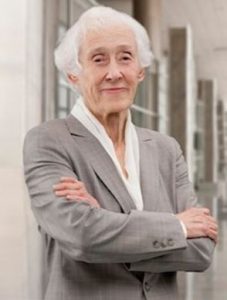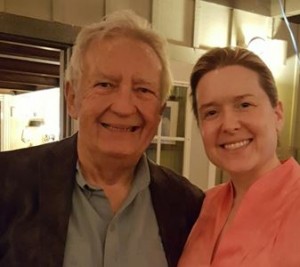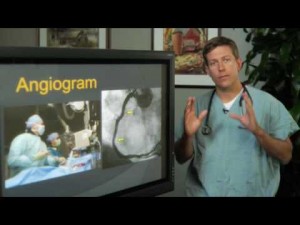
March 27th, 2017 by Dr. Val Jones in Health Policy, True Stories
Tags: Ageism, Bias, healthcare, Medicine, Rehabilitation, Senior Profiling, Seniors
No Comments »
 We’ve all heard the saying, “age is just a number.” Nowhere is that more important than in the hospital setting. Over the years I’ve become more and more aware of ageism in healthcare – a bias against full treatment options for older patients. Assumptions about lower capabilities, cognitive status and sedentary lifestyle are all too common. There is a kind of “senior profiling” that occurs among hospital staff, and this regularly leads to inappropriate medical care.
We’ve all heard the saying, “age is just a number.” Nowhere is that more important than in the hospital setting. Over the years I’ve become more and more aware of ageism in healthcare – a bias against full treatment options for older patients. Assumptions about lower capabilities, cognitive status and sedentary lifestyle are all too common. There is a kind of “senior profiling” that occurs among hospital staff, and this regularly leads to inappropriate medical care.
Take for example, the elderly woman who was leading an active life in retirement. She was the chairman of the board at a prestigious company, was an avid Pilates participant, and the caregiver for her disabled son. A new physician at her practice recommended a higher dose of diuretic (which she dutifully accepted), and several days later she became delirious from dehydration. She was admitted to the local hospital where it was presumed, due to her age, that she had advanced dementia. Hospice care was recommended at discharge. All she needed was IV fluids.
I recently cared for an attorney in her 70’s who had a slow growing brain tumor that was causing speech difficulties. She too, was written off as having dementia until an MRI was performed to explore the reason for new left-eye blindness. The tumor was successfully removed, but she was denied brain rehabilitation services because of her “history of dementia.”
Of course, I recently wrote about my 80-year-old patient, Jack, who was presumed to be an alcoholic when he showed up to his local hospital with a stroke.
Hospitalized patients are often very different than their usual selves. As we age, we become more vulnerable to medication side-effects, infections, and delirium. And so, the chance of an elderly hospitalized patient being acutely impaired is much higher than the general population. Unfortunately, many hospital-based physicians and surgeons — and certainly nurses and therapists — have little or no prior knowledge of the patient in their care. The patient’s “normal baseline” must often be reconstructed with the help of family members and friends. This takes precious time, and often goes undone.
Years ago, a patient’s family doctor would admit them to the hospital and care for them there. Now that the breadth and depth of our treatments have given birth to an army of sub-specialists, we have increased access to life-saving interventions at the expense of knowing those who need them. This presents a peculiar problem – one in which we spend enormous amounts of resources on diagnostic rabbit holes, because we aren’t certain if our patients’ symptoms are new or old. Was Mrs. Smith born with a lazy eye, or is she having a brain bleed? We could ask a family member, but we usually order an MRI.
My plea is for healthcare staff to be very mindful of the tendency to profile seniors. Just because Mr. Johnson has behavioral disturbances in his hospital room doesn’t mean that he is like that at home. Be especially suspicious of reversible causes of mental status changes in the elderly, and presume that patients are normally functional and bright until proven otherwise.
Last month I hit a new age record at my rehab hospital – I admitted a charming, active, 103-year-old woman after a small stroke caused her some new weakness. She was highly motivated in therapy, improved markedly and was discharged to an independent living center. I bet she will live many more years. When I joked that she didn’t look a day over 80, she winked and told me she had stopped counting birthdays years ago. She said, “It doesn’t matter how old you are, it matters what you can do. And I can do a lot.”
February 3rd, 2017 by Dr. Val Jones in True Stories
Tags: Locum Tenens, Patient Advocacy, Patient Stories, PM&R, Stroke
1 Comment »
 Even though I don’t have an outpatient practice, I like to keep in touch with some of my patients after they’ve discharged from the rehab hospital. Jack is one of my very favorite success stories.
Even though I don’t have an outpatient practice, I like to keep in touch with some of my patients after they’ve discharged from the rehab hospital. Jack is one of my very favorite success stories.
I met Jack in a small regional hospital in rural western America. He had been admitted with sudden onset weakness, and during the intake process, accurately described his daily evening cocktail habit. Unfortunately, this led the clinicians down the wrong diagnostic pathway, presuming that alcohol withdrawal seizures were the cause of his weakness (due to a presumed “post-ictal” state).
A brain MRI was unremarkable, and so a fairly high loading dose of anti-seizure medications were started. Poor Jack happened to be very sensitive to meds, and reacted with frank psychosis. Days later he was still not in his right mind, and so a rehab consult was requested for “encephalopathy due to alcohol withdrawal.”
When I met Jack, it was clear on first glance that… [click here to read the rest of the story] or go to this link:
http://cliniciantoday.com/when-its-more-important-to-save-a-lifestyle-than-a-life/
August 4th, 2016 by Dr. Val Jones in True Stories
Tags: Amazing Coincidence, rehab, St Luke's Rehabilitation Institute, Tulane Medical Center
1 Comment »
As the new medical director of admissions for St. Luke’s Rehabilitation Institute in Spokane, Washington, it is my job to review all patient referrals to our hospital. Imagine my astonishment when, while traveling to New Orleans, I received an email about a patient at Tulane Medical Center who was requesting admission to St. Luke’s. This dear lady was from Spokane, but had fallen ill while visiting her family on the other side of the country, in Louisiana.
I quickly discovered via Google Maps that she was in a hospital bed only three blocks from my hotel room. I called the case manager and nurse at Tulane and asked if it was OK for me to stop by the patient’s room for an interview. They were surprised to hear that a consult physician from Washington was going to meet their patient in person, but thought it would be fine.
When I arrived, the patient’s son greeted me. He was pacing the halls, worrying about how he was going to get his mom home. There was only one direct flight per week, and it was scheduled for the next day. He had booked the ticket on Southwest Airlines on a lark.
I explained that I was from St. Luke’s, the facility that he hoped would admit his mom for further care.
He was dumbfounded. “What are you doing in New Orleans?” he asked.
“I’m here on a business trip,” I said, “and I heard your mom needed rehab. I wanted to look in on her and make sure she’s ready to transfer home. I reviewed her chart and she seems to be a perfect candidate.”
He smiled and sputtered that he thought the case managers had just sent out the referral request a few hours prior. “How on earth did you get here so quickly?” he marveled.
I explained that email and digital chart access make a big difference these days and reassured him that his mom would likely be able to catch her flight the next morning.
As I entered the patient’s room, I introduced myself as a doctor from St. Luke’s in Spokane, who had come to see if she was ready for admission. She looked at me with bright, quizzical eyes.
“I thought this was going to take weeks,” she said. “I was in such a state. I prayed that God would find a way to get me home just a few hours ago, and now you’re here. This must be divine intervention.”
I smiled and briefly examined her, noting a PICC line and Foley catheter. She wrote me a list of “must eats” in New Orleans and explained where I could find the best fried oysters and po’boy sandwiches. Her attending physician then came in, accompanied by a medical resident. The resident explained that I was here from the accepting facility in Washington state.
“This never happens,” the attending stated, matter-of-factly.
“It’s a crazy coincidence. I am the admissions director, and I happened to be three blocks from here when I received an email about this patient,” I said. “I reviewed a copy of your medical records and believe she is an excellent rehab candidate. Because I was right around the corner, I figured I’d facilitate her transfer in person. It’d be great if we could leave her lines and tubes in for the trip. … I’d like to give you my card, in case you have other patients who need rehab in Spokane.”
The attending chuckled as she looked at my business card. “I’m not sure how many others we’ll be sending your way.”
“You never know.”

Dr. Val Jones and patient Patricia Crocker-Fox in Spokane, WA.
The patient transferred to St. Luke’s the very next morning, arriving before I did. She made an excellent recovery, and after three weeks of hard work, she was able to stand and walk again.
She gave me permission to write about this amazing journey, and I had a hospital friend take a photo of us together on her final day at St. Luke’s, next to a full-scale replica of the same Southwest Airlines airplane in which she traveled to us from New Orleans. We use it in our gym to help patients with injuries and disabilities practice getting in and out of airplanes. Southwest Airlines donated it to us some time ago — yet another coincidence!
Stories like these make me glad to be a physician. I love knowing that I may be called upon at any time — wherever I am — to help people in extraordinary ways.
And yes, I did gain about five pounds on my trip. What can I say? I simply had to take my patient’s advice on Cajun delicacies before I flew home!
**This post was originally published on the Barton Associates Blog.**
May 24th, 2016 by Dr. Val Jones in True Stories
Tags: Animal Injury, Bison, Buffalo, Gore, Rehabilitation
No Comments »
 *This post was initially published on the Barton Blog.
*This post was initially published on the Barton Blog.
As a locum tenens physician in rehabilitation hospitals, I see patients with some of the most unique injuries. From rare brain infections contracted in exotic lands, to the consequences of ill-advised horseplay with guns or ATVs – I’d begun to wonder if maybe I’d seen it all.
And then I met a grandma from New Jersey, who had a life-changing encounter on a nature trail out west. In her dutiful effort to corral her teenage grandchildren, and keep them following the guide’s directions, she shouted for them to remain on the path. In so doing, her yelling attracted the attention of an ill-tempered bison. The animal rapidly approached from behind without her notice. In the blink of an eye, the bison threw her up in the air with a flick of its horned head.
“As a locum tenens physician in rehabilitation hospitals, I see patients with some of the most unique injuries.”
As she crashed to the ground, she rose up again instinctively (to dust herself off and prepare to run) as the animal came back for a second hit. One of its horns sliced a huge gash in her buttock as she fell head first on the ground, causing brain bleeding. The guide managed to scare off the beast as my patient’s granddaughter had the presence of mind to staunch her bleeding wound by having her sit on her thigh, as the guide called in an air flight to my hospital.
After stabilization in the ICU and several surgeries to correct the gashes, my patient arrived in the rehab unit with a traumatic brain injury. She was quite disoriented, her pain was poorly controlled, and even the slightest noises were very disturbing to her. She had flashbacks of the event and would call out in fear during her fitful sleep.
With careful therapy, low stimulus environment, and better pain management, I began to see glimpses of my patient’s usual brilliance and keen sense of humor. She was determined to improve, and participated eagerly in the full gamut of activities, including focused attention tasks and balance and agility tests.
One weekend I was eating at a local restaurant and noticed bison carpaccio on the menu. I couldn’t resist the opportunity to “get even” for my patient. I ordered the dish and took a photo with my smart phone. On Monday I showed her the image – and told her I had evened the score. Her face lit up from ear to ear. She told me to keep eating buffalo for the rest of my days!
December 28th, 2015 by Dr. Val Jones in True Stories
Tags: Cardiac Electrophysiologist, CHF, Ejection fraction, Heart Disease, How To Relay Information, What Does It Mean? Cardiologist
1 Comment »
 Most physicians will be thrust into the role of patient or caregiver at some point during their careers. Unfortunately, it’s not until this occurs that many become fully aware of the finer points of excellent care and communication. Take for example, the simple act of reporting test results to a patient. We do this every day, but may not realize that how we frame the information is as important as the data themselves.
Most physicians will be thrust into the role of patient or caregiver at some point during their careers. Unfortunately, it’s not until this occurs that many become fully aware of the finer points of excellent care and communication. Take for example, the simple act of reporting test results to a patient. We do this every day, but may not realize that how we frame the information is as important as the data themselves.
I came to realize this on a recent hospital visit when I was in the role of healthcare proxy for a loved one with heart disease. Not only did various physicians present information with different degrees of optimism, but individual doctors presented things differently on different days… depending on (I guess) how tired/hurried they were. Consider these different messages with the same ejection fraction (EF – a measure of heart pump strength) and angiogram (heart vessel imaging) test results:
Doctor 1: “I wish I had better news. The EF is lower than we thought. It is low because of your previous massive heart attack.”
Doctor 2: “Although your EF is impaired, there’s a lot that can be done to improve pump function with medications.”
Doctor 1 (different day): “On the other hand, the EF might be temporarily low because of your recent flu infection. It’s possible it will bounce back in a couple of months and you’ll be back to your usual self.”
Doctor 2: “I’m not worried about your chest pain because we know it’s caused by small vessel disease. Your angiogram showed that all your main heart arteries are wide open. The pain is not dangerous, though I’m sure it’s annoying.”
Doctor 1: “Chest pain is always serious. You never know when it could be the big one.”
Doctor 3: “It’s hard to interpret EF because some people live long and productive lives with low EFs, and others are quite impaired with only a small dip in pump function.”
Doctor 2: “Sure there are medications we can try to improve your EF, but I doubt you’ll tolerate them because your blood pressure is kind of low.”
Doctor 3: “Don’t worry about the EF, it will correct on its own once we get your rhythm controlled. This is an electrical problem, not plumbing.”
All of this emotional whiplash caused by the same test results… due to different physicians’ interpretations of prognosis and treatment options. What can be done? First of all, we physicians need to take a deep breath and realize how our words affect our patients. They are scared and vulnerable, and they are looking to us for hope… and when there is real hope, why not emphasize it? There is no need to focus on the worst-case scenarios until we are well and truly in their midst.
I believe that being a good clinician is not just about giving patients factual information, but also about presenting data with kindness. Sometimes, as I’ve discovered with my own loved one, it’s not as important what you say, as how you say it.
 We’ve all heard the saying, “age is just a number.” Nowhere is that more important than in the hospital setting. Over the years I’ve become more and more aware of ageism in healthcare – a bias against full treatment options for older patients. Assumptions about lower capabilities, cognitive status and sedentary lifestyle are all too common. There is a kind of “senior profiling” that occurs among hospital staff, and this regularly leads to inappropriate medical care.
We’ve all heard the saying, “age is just a number.” Nowhere is that more important than in the hospital setting. Over the years I’ve become more and more aware of ageism in healthcare – a bias against full treatment options for older patients. Assumptions about lower capabilities, cognitive status and sedentary lifestyle are all too common. There is a kind of “senior profiling” that occurs among hospital staff, and this regularly leads to inappropriate medical care.


 Even though I don’t have an outpatient practice, I like to keep in touch with some of my patients after they’ve discharged from the rehab hospital. Jack is one of my very favorite success stories.
Even though I don’t have an outpatient practice, I like to keep in touch with some of my patients after they’ve discharged from the rehab hospital. Jack is one of my very favorite success stories.
 Dr. Val Jones and patient Patricia Crocker-Fox in Spokane, WA.
Dr. Val Jones and patient Patricia Crocker-Fox in Spokane, WA.
 *This post was initially published on the
*This post was initially published on the  Most physicians will be thrust into the role of patient or caregiver at some point during their careers. Unfortunately, it’s not until this occurs that many become fully aware of the finer points of excellent care and communication. Take for example, the simple act of reporting test results to a patient. We do this every day, but may not realize that how we frame the information is as important as the data themselves.
Most physicians will be thrust into the role of patient or caregiver at some point during their careers. Unfortunately, it’s not until this occurs that many become fully aware of the finer points of excellent care and communication. Take for example, the simple act of reporting test results to a patient. We do this every day, but may not realize that how we frame the information is as important as the data themselves.









